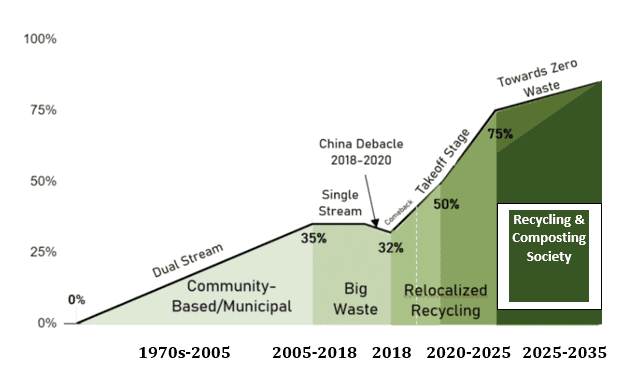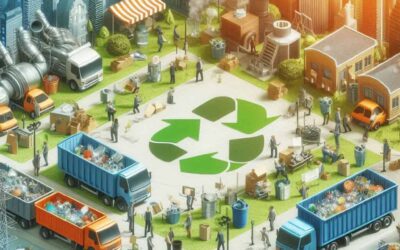The Second Recycling Revolution – Part 1
By Guest Authors Neil Seldman, The Recycling Cornucopia Project, Zero Waste USA and
Susan Kinsella, Conservatree and The Recycling Archives
After 20 years of stagnation, recycling is gaining momentum again. But, as the country moves forward from its somnolence, shaken by China’s ban on importing contaminated materials, headwinds from “Big Waste,” Big Packaging and Big Soda are also gathering to halt this Second Recycling Revolution in the U.S. so they may continue profiting from wasting.
The First Recycling Revolution emerged in the early 1970s from the grassroots. Regular citizens, applying immense self-reliance, imagination and boldness – housewives, college students, airline pilots and flight attendants, stand-up comics, lawyers, doctors, teachers and children – started the recycling movement. Fed up with the Vietnam War, overconsumption, and waste and despoliation of nature, this motley crew started rudimentary recycling drop-off centers in backyards, old gas stations and abandoned strip malls as a way to make personal statements of concern and alarm. “Just Do It” was the call to action, and “Reduce, Reuse, Recycle!” the battle cry.
Cliff and Mary Humphrey’s Survival Walk in 1969 from San Diego to Sacramento raised awareness and inspired many of the earliest community recycling efforts in California. Each day, they stopped to start a new recycling drop-off center in towns along the way.
Kathy Evans, one of those inspired by the Humphreys’ citizen action events, recalls about her later pioneering work with the Ecology Center in Berkeley, “Our whole view of reality was changing. It’s funny to me now, because we didn’t yet have the idea of Zero Waste, but ‘no waste’ was what we thought was possible. Our whole goal even then was to replace garbage collection with a new system that would handle everything as a resource, not a waste. It was some sort of large comprehensive collection system that we had to build. Ahead of that, even from the beginning, all of the recyclers I knew were all about not using things wastefully in the first place. That goal – to replace garbage collection with a new system that would handle everything as a resource, not a waste – is the key.”[1]
Recycling Thrives and Expands
Some of the drop-off centers and small-scale family collection companies spontaneously started curbside collection ventures in the early 1970s that became the model for municipal community programs in the 1980s. By then, public pressure was making recycling a permanent part of municipal services. That shift, augmented by the anti-incineration (1980s) and Zero Waste[2] (1990s) movements, captured the hearts and minds of the average American, spurring a grassroots movement that reached a national recycling level of 35% and still has agency.
This robust start was nonetheless stymied by “Big Waste” (national, vertically integrated waste hauling and landfill companies) in the early 2000s, when cities were jockeyed and seduced into dropping dual-stream collection and implementing single stream recycling collection programs, often with out-of-town shipment of low-value mixed materials to centralized processing plants. These waste monopolies had also come to dominate the processing of materials, thus closing off options for cities and counties to integrate efficient local and regional collection, processing and manufacturing.[3]
The combination of transportation costs and poor processing with no glass recovery – even though glass was 25% of the recycling stream – characterized this sloppy and wasteful system. It worked because China, for its own reasons, accepted these raw materials as part of a temporary way to jump-start their own industrialization plans.
The system stopped working, however, when China reached production levels that generated enough materials that it could depend on its own internal recycling, as well as an increased wage scale and solutions to serious environmental concerns over primitive recycling practices. U.S. recycling fell to 32%. Only increased composting kept the rate from falling further.
Trajectory of Modern U.S. Municipal Recycling

The GOOD NEWS: The Recycling Phenomenon is Back by Popular Demand
The Second Recycling Revolution began in 2018, after China’s National Sword policy banned highly contaminated single-stream materials from the U.S. Despite the fact that China had been warning for years that this cut-off was coming, U.S. recyclers were stunned and unprepared. But eventually, as prices for secondary materials fell in the tumult caused by the Chinese ban, private investment began re-building the U.S. manufacturing sector, and end-use capacity that had languished during the years that recycling collectors shipped a large percentage of materials to China rather than supplying domestic mills, returned to use.
The Second U.S. Recycling Revolution is underway. The paper industry has invested billions for refurbishing and expanding existing and new paper and packaging recycling mills. Funding has flooded into advancing plastics recycling capacity and technology, and industries for processing and repairing electronic discards are flourishing.
Forward-thinking companies pivoted to rediscovering local markets. “We woke up because of the China ban, and I’m glad we woke up… If plastic scrap is a valuable commodity in other countries, then it is also valuable here,” said Sunil Bagaria, CEO of New Jersey-based GDB International, Inc. “There is more value in selling pellets than in selling scrap… the investment will pay off multiple times.”
In the wake of National Sword, GDB International went from exporting plastic film scrap overseas to pelletizing it into post-consumer resin for domestic sale. Other companies also pivoted to markets in North America for their PET, HDPE, PP and plastic film bales. Investment is coming not only from U.S. companies but also from Chinese, European, and South American companies, as well.
[1] Kathy Evans interview, “The Founders’ Hearts,” The Recycling Archives, 2019 [2] The concept and practice of Zero Waste began in 1995 after Dan Knapp, Urban Ore, returned from a visit with activists in Canberra, Australia. [3] Fighting Monopoly Power in Waste, Neil Seldman and David Morris, ILSR, 2020 The article originally appeared in the National Recycling Coalition Newsletter December 2022. https://nrcrecycles.org/




